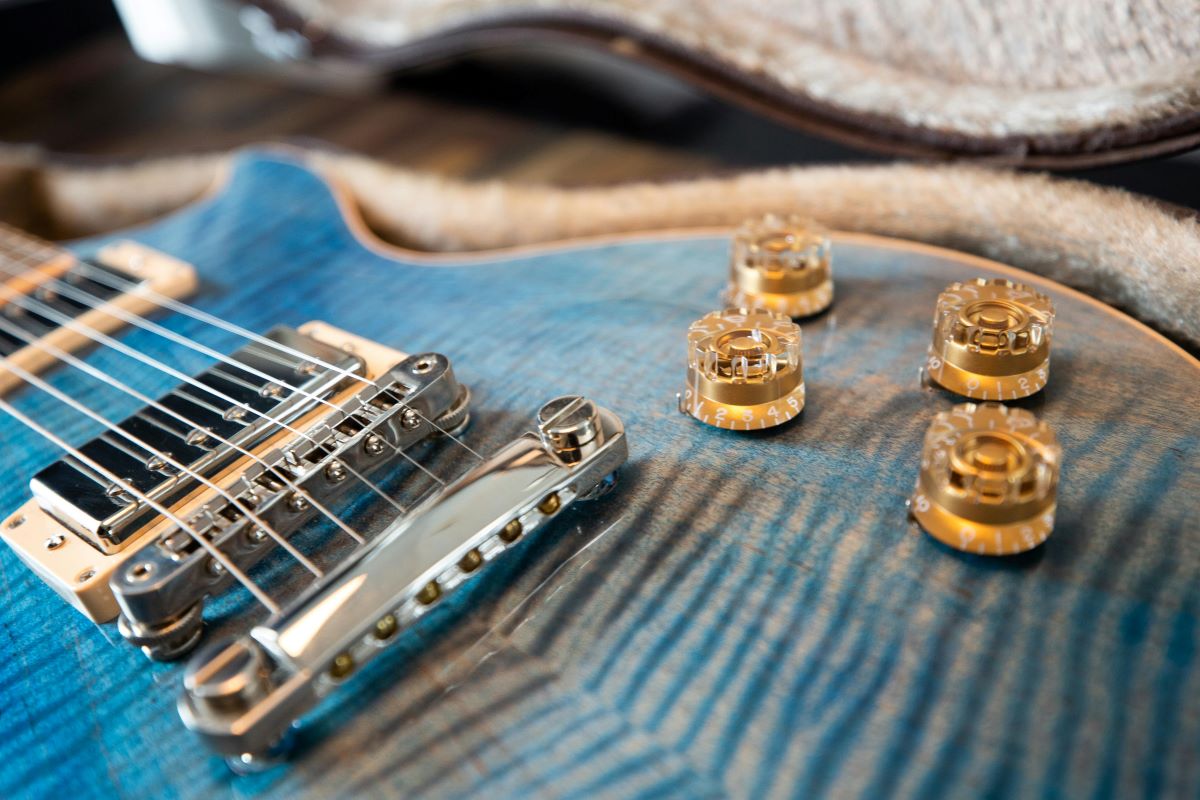Well, here we are again, for the second installment of our in-depth look at alternative tunings, so let’s not waste any time and get straight to it with…
Open Tunings
All the tunings I covered in Part 1 were loose alternatives to standard tuning, but what if we take it a step further and tune the whole guitar to a chord?
Welcome to the mystical land of open tunings…
Open tunings involve tuning every string to a note within a chord (usually a major chord); therefore, if you strum the guitar without fretting any notes, you will hear the full open chord. They are particularly useful for playing slide guitar, allowing you easy access to a lot more notes than when playing slide using standard tuning.
They are also widely used in folk and country for their unique sound, especially when fingerpicked. The tuning also allows for interesting songs to be created using only a few fretted notes, while keeping most of the open chord ringing.
But they are not only for slide, folk, and country; open tunings are also regularly adapted by rock and indie artists for a song or two.
Let’s take a look at a few…
Open D - D-A-D-F#-A-D
The D major chord consists of three notes - D-F#-A. Therefore, to create the Open D tuning, two strings remain in standard tuning, while the rest are lowered in pitch to become one of the three chordal notes.
The E string is lowered by a whole tone to become a D, while the A and D strings are left as they are. Then you need to lower the G string by a semitone to become an F#, lower the B string by a whole tone to become an A, and finally, lower the high e string by a tone to become another D note.
Voila! You’re now in Drop D tuning, give the open strings a strum, don’t they sound great?
It’s been used by artists such as Bob Dylan, Joni Mitchell, and Seasick Steve, and bands like The Black Crowes, Pearl Jam, Mumford and Sons, and Alice in Chains.
Here’s the Full TAB of Stone Gossard’s guitar parts in Even Flow using Open D tuning
Open E - E-B-E-G#-B-E
As with the open D tuning, we need to create an open E chord across all six strings. An E major consists of E-G#-B, so we can leave the low and high e strings, as well as the B string, tuned as normal. Next, raise the pitch of the A string by a whole tone to a B, raise the D string by a whole tone to an E, and the G string by a semitone to a G#.
Probably the best song ever recorded using the Open E tuning is the rhythm guitar part for the Rolling Stones classic ‘Gimme Shelter’. The tuning was also used for almost all the songs on Bob Dylan’s ‘Blood on the Tracks’ album, as well as the slide guitar part on Joe Walsh's ‘Rocky Mountain Way’.
Full Gimmie Shelter TAB in Open E tuning
Open G Tuning - D-G-D-G-B-D
I’m sure that you’ve got the hang of tuning your guitar to open tunings by now, so I won’t waste time explaining this or the next one. Work out if you can leave some of the strings as they are (for an Open G, that’s the D, G and B strings), then just tune up or preferably down (we don’t want to be breaking any strings, do we!) to the chordal note you need on each string.
Open G Overtones Tuning - G-G-D-G-B-D
This is a variation of the G tuning above, but following the overtones. The low D note is replaced by a G note, giving you G-G-D-G-B-D. It was widely used by Mick Ralphs in Bad Company, and Joni Mitchell in ‘For the Roses’ (Capo 3rd fret).
Or, get the thickest string off your guitar, leaving you with only five - G-D-G-B-D - and then get your strut on, doing your very best impression of Keith Richards. He used this five-string tuning on ‘Honky Tonk Women’, ‘Start Me Up’ and ‘Brown Sugar’.

Here’s the full Brown Sugar TAB in G Overtones Tuning. Ignore the sixth string, Keith doesn’t have one!
More Folky and Funky Tunings
Led Zeppelin's Jimmy Page is not only one of the greatest guitarists, songwriters, and all-around cool dudes in history, but also one of the most prolific users of alternate tunings when songwriting.
This was mainly in the band's quieter, more folk-influenced material, but unusual tunings also made their way into louder songs such as Kashmir, which features D-A-D-G-A-D.
DADGAD was devised by British folk revival pioneer guitarist Davey Graham in the early 1960s, before being adopted by acoustic supremos such as Bert Jansch, John Renbourn, Martin Carthy, John Martyn, as well as Page.

Here’s the full Kashmir TAB in DADGAD
Let’s move from one epic song to another, Zeppelin’s The Rain Song. This is tuned in D-G-C-G-C-D. Lower the thickest three strings by a whole tone, leave the G string as it is, raise the B string by a semitone to a C, and lower the high e string by a whole tone, and you’ll have yourself a magical, mystical tuning to charm the elves out of their hidey-holes.
Live, Page would usually tune a step higher than the studio recording - to E-A-D-A-D-E - making the transition easier

Full The Rain Song TAB in DGCGCD.
I could go on and on for days with Jimmy Page’s inventive use of alternate tunings to create some of the most beautiful rock music ever written, but I’m afraid that there just isn’t time, so, here is a list of famous Zeppelin songs and the tunings so that you can either learn them, or better still, experiment with the tunings yourself…
D-G-D-G-B-D
-
When The Levee Breaks
-
Traveling Riverside Blues
-
Dancing Days
-
Black Country Woman
Db-Ab-Db-Gb-Ab-Db
-
Black Mountain Side
C-F-C-F-A-C (sometimes D-G-D-G-B-D)
-
Bron-Y-Aur Stomp
C-A-C-G-C-E
-
Bron-Y-Aur
-
Poor Tom
-
Friends
A-A-A-E-G-Db
-
Celebration Day
D-A-D-G-B-D
-
Going To California
C-G-C-E-G-C
-
Hat's Off To Roy Harper
E-A-E-A-Db-E
-
In My Time Of Dying
D-A-D-G-B-E
-
Moby Dick
Db-Gb-Db-Gb-Bb-Db
-
That's the Way
Let’s finish by getting even more experimental with some…
Crazy Guitar Tunings
I know that I’ve already included her name many times, but some artists have taken guitar tunings to such another level that they need their own section. And one of them is undoubtedly the Queen of Alternative Tunings, Joni Mitchell. In fact, she has created so many tuning variations that she can’t remember lots of the earlier ones anymore.
I’m not going to go into all the tunings she uses, or I’d be here forever; there are entire books written on the subject. To find out more, check out the tuning page of her official website.
However, she also used some more common alternate tunings such as open D, which has already been discussed. For example, in the song ‘Both Sides Now’, as shown below in this live performance from 1969, with the guitar capo’d at the fifth fret…
Some bands have also taken tuning to the extreme, with Sonic Youth being one of my personal favorites. Their complete obsession with alternate tunings meant that they used to tour with up to 43 guitars between both guitarists, which were nearly all tuned differently.
Each one has a piece of tape behind the headstock with the tuning written on it, and the string gauges might not go from thickest to thinnest, but sometimes have a variety of string gauges in various orders to create the unusual tunings. Plus, Thurston Moore and Lee Ronaldo never play two guitars with the same tuning at the same time - that would make it far too ‘normal’. Kim Gorden, the bassist, however, sticks with standard tuning - E-A-D-G.
Yes, they’re a bit mad, but the underlying reason behind all the crazy tunings is to write music that is in no way formulaic. Listening to any Sonic Youth song for the first time is a unique experience where you’ll constantly hear things you’ve never heard before - in any song!!!
Their approach to songwriting is purely sonic; they never play anything cliched, because playing Em to G to D to C doesn’t work on any of their guitars. Therefore, they write by moving their fingers around until they find a sound they like that works with what the rest of the band is playing.
As an example, the song ‘Dirty Boots’ where Thurston Moore is tuned to E-G-D-G-E-D while Lee Ranaldo is tuned to E-E-B-B-E-F#, or ‘Washing Machine’ where Thurston uses G-G-D-D-D#-D# while Lee plays two different guitar parts, one tuned to A-F#-E-F#-E-B, and the other tuned to G-G-C-G-C-D - confusing or what?
Here’s the Full Dirty Boots TAB for both guitars for those of you who really want to experiment with your alternate tunings.
For the tunings to all their songs, check out the official Sonic Youth site’s tuning page.
Wrapping it Up!
I know great musicians who have played all their lives and have stayed in standard tuning for 99% of it. A little bit of drop D-tuning occasionally for the odd song here and there, but nearly always sticking with what they know.
I think this is a great shame, they don’t need to get into insane experimental tunings, such as Sonic Youth, but trying a bit of D-A-D-G-A-D or something similar can open so many musical doors and make us realise that we are not all confined to the big box that is standard tuning.
So, experiment. Tune your guitar to something more unusual and mess around with it. But be patient, it might take some time to get your head around what your hands are doing. However, if you stick with it, your guitar will start producing sounds that you’ve never heard before, and that’s truly exciting.
From then on, the wonderful world of alternate tunings will be in your musical soul, and you’ll be hooked forever! Enjoy!!!






Share:
Alternate Guitar Tunings: Everything You Need To Know - Part 1 - Standard Tuning Variations and Drop Tunings
String Trees: How can such a Small Part have a Big Impact on Your Tone